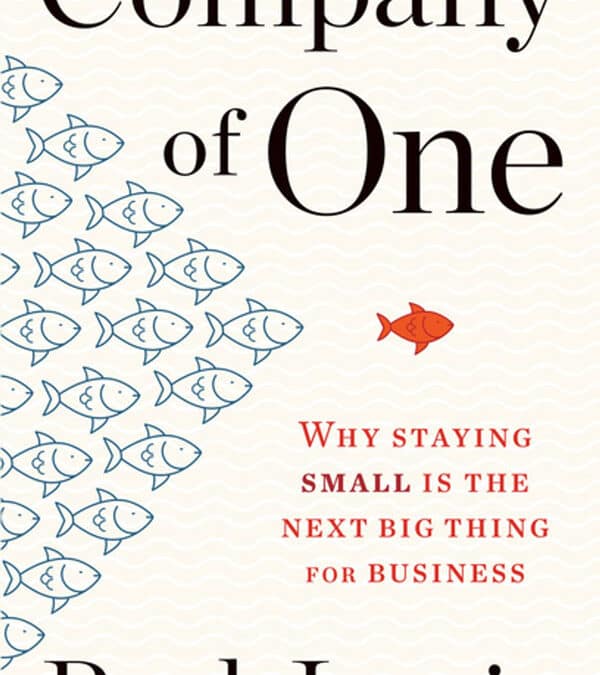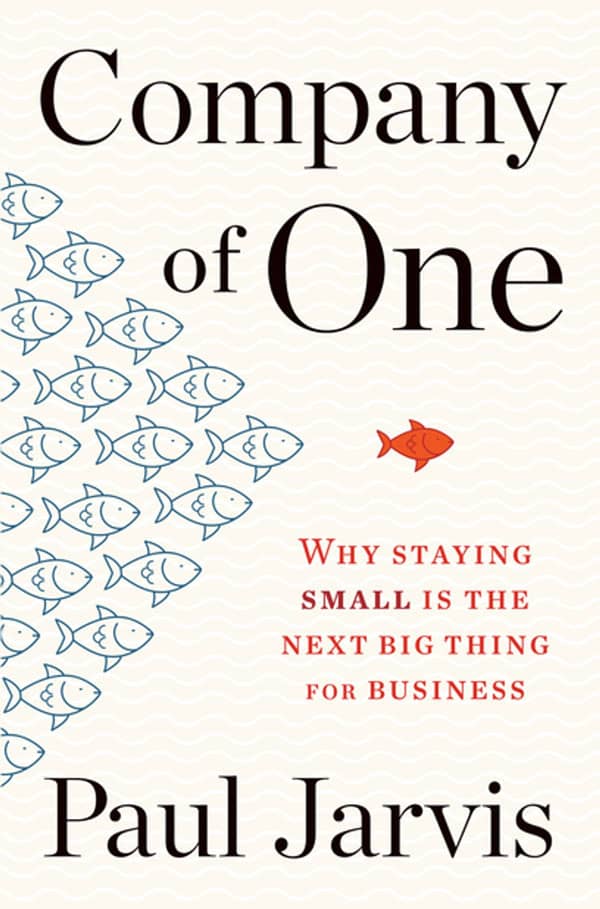Company of One, Why Staying Small Is the Next Big Thing for Business by Paul Jarvis
Recommendation
Most companies want to get bigger and earn more. They hire more people, set up big offices and seek more buyers. A “company of one” stays small on purpose. In his bestseller, Paul Jarvis, a company of one himself, shows you how to start and run a small firm, though not necessarily a one-person operation. You can be a small group in a larger organization, but in a small firm, you know what your clients want because you talk to them. Jarvis alludes to one caveat: Staying small sounds ideal, but consider how much time you’d need for marketing, administration and such to live small and thrive.
Take-Aways
- The leader or leaders of a “company of one” question the mind-set that more is always better.
- A company of one needn’t be only one person.
- Those who start a company of one value – and can nurture – resilience, autonomy, speed and simplicity.
- Start small and launch quickly. Simplify any complex idea.
- Being a company of one brings unique challenges.
- If you need outside money, crowdfunding is preferable to venture capital.
- Define the upper and lower financial limits of what you want to earn.
- Show customers why they should buy from you. Share your mind-set and unique personality.
- Larger companies focus on growth. They hire more employees to get more customers and create more overhead.
- Build trust and empathy, and show your humanity.
Company Of One Book Summary
The leader or leaders of a “company of one” question the mind-set that more is always better.
Most companies want more – more customers, more employees, more profit – but having more comes with a higher cost. You can actually do more with less. A company of one enables you to take control of your business and your life.
“A company of one is simply a business that questions growth.”
Being a company of one isn’t the same as being a freelancer. Freelancers get paid only when they work. A company of one uses systems and automation to make a profit even when its owners aren’t working.
A company of one needn’t be only one person.
It can be one person, one person within a larger organization, or a small firm with a few employees. For example, employees or board members can be a company of one inside a much larger company if they desire autonomy and question the more-is-better mind-set.
Those who start a company of one value – and can nurture – resilience, autonomy, speed and simplicity.
Some people abandon traditional companies because they want more autonomy and control over their lives. To succeed as a company of one, you must be highly competent at whatever skill you sell. That requires putting in time at a traditional company to achieve mastery. With greater autonomy comes more responsibility. You might trade a demanding boss for demanding clients, especially in the beginning when you can’t afford to be as selective as you’d prefer.
Kaitlin Maud, a freelance digital strategist, worked for an agency for five years before venturing out on her own. Maud works best from 9:00 a.m. to 1:00 p.m., so she schedules no calls or meetings in that time slot. When she started, she worked on improving her skills, and now she has a client waiting list. Now, Maud can do in four hours what used to take her eight because she works more efficiently.
“Making money is often easier than earning trust, because money can be lost and won back without judgment, whereas trust is hard to regain once it’s lost.”
Companies of one are nimble and thrive under time constraints. Because they don’t have layers of bureaucracy, they easily can pivot to meet customers’ needs. They work smarter, not harder. Companies of one keep it simple. Most large companies lose sight of their overall mission as they continue to grow and expand. If you have an idea for a business, start small. If your business requires a lot of time, effort and resources, scale it back and keep it simple. Build it up later, once you’ve mastered taking care of one client or only a few clients.
Start small and launch quickly. Simplify any complex idea.
Sean D’Souza runs a company of one making $500,000 a year, and that is his goal. His consulting firm, Psychotactics, uses its website and training sessions to teach sellers the psychology of why customers buy. D’Souza wants a quality of life that includes time off with his wife and family. To take a three-month vacation each year, he wakes up daily at 4:00 am to record his podcast and answer online questions from customers. D’Souza works on making his company better for his existing customer base rather than trying to find new customers. He sends every customer a handwritten thank-you note and a box of chocolates with each purchase. Even if they’re spending $2,000 on a training class, the box of chocolates resonates with clients.
“It’s much easier as a smaller business to compete on the personal touches – going the extra mile and treating customers like humans, not numbers. That’s a major advantage for any company of one.”
Get to know your first customers to learn what made them buy from you. Figure out how you can continue to make them happy. If you do, they’ll never leave, and they’ll recruit new customers for you.
Being a company of one brings unique challenges.
Alexandra Franzen is an author and freelance writer for Time, Forbes, Newsweek and other publications. She used to have a full-time job in radio broadcasting. After quitting that job, she emailed everyone she knew saying she was looking for freelance writing projects. Almost all of her initial 60 contacts wrote back to hire her or suggest a contact. Franzen started with three small projects, which led to three more new clients. Now she’s booked almost a year in advance.
Without co-workers or employees, you need to be self-motivated. You must avoid distractions and concentrate on your work. According to John Pencavel, a Stanford University researcher, most people’s focus declines after 55 hours of work a week, so you have to watch your attention level.
Jocelyn Glei, the best-selling author of Unsubscribe, believes that avoiding distractions is paramount to getting more done. She recommends running a personal productivity audit once or twice a year. To understand how to perform a task more efficiently, first write down how long it takes. If you have a boss, let him or her know your priorities. Account for busy work that eats up time, such as answering emails and having meetings.
“What’s difficult to automate is exactly what makes a company of one great: the ability to creatively solve problems in new and unique ways without throwing ‘more’ at the problem.”
Companies of one need to launch quickly to make a profit. Determine your “minimum viable profit” (MVPr) – the number you need to reach to be profitable. The lower the number, the easier it will be to achieve, so cut down on expenses and start small. If you make a profit from the start, add more features or products later. Your MVPr should be low in the beginning also because you need to cover yourself as the owner plus any early employees.
Companies of one should focus on profitability first and growth second. Traditional companies embrace the opposite. They invest in future growth by increasing staff, adding technology, acquiring other companies, and the like. Their eventual goal is to turn a profit, but this comes later because their expenses are high. With your company of one, you won’t learn anything until you launch. Then learn from your mistakes and refine what doesn’t work.
If you need outside money, crowdfunding is preferable to venture capital.
If you need outside funding as a company of one, your options generally are venture capitalists (VCs) or online crowdfunding. Companies of one are ideal for crowdfunding, which means you think of a product, announce your idea online and ask for money up front to build your company. If customers like and want your product, they’ll financially support for your idea. However, only 35% of campaigns started on Kickstarter, a popular crowdfunding website, reach their funding goal. Women are 32% percent more successful than men at using crowdfunding.
“Venture capital can be a quick way to infuse money into a company to help it succeed, but it’s not a requirement, and it definitely comes with certain pitfalls.” ”
On the other hand, VCs can provide mentorship and help you build business relationships – even though their help comes with strings. They’re personally invested because they expect a cut of your profits. And, trends show that white male venture capitalists tend to fund other white males.
Define the upper and lower financial limits of what you want to earn.
Companies of one should set and define their low and high fiscal boundaries. You might define your objectives in terms of profit or, perhaps, the number of people on your mailing list. Another way to earn is to teach your customers to use your products more effectively or – if you’re a service provider – to teach them the skills to use your service more fully.
“Education makes a real difference between a product that people perfunctorily buy for utilitarian reasons and a product they are truly eager to purchase because it adds real purpose to their lives. ”
A company of one needs guidance and boundaries. While you need to sell yourself based on your skills, you must also understand marketing, bookkeeping and sales – or be able to outsource those tasks. You also need sound communication skills.
Working for yourself might sound riskier than working for a regular company. But there are no guarantees that corporate jobs are any safer due to the perils of bankruptcy, layoffs, take-overs, and the like. The US Census Bureau reports that the number of self-employed individuals with no employees who still earn an annual revenue of $1 million grew by 6% in 2015 and that 38,029 companies across a range of industries generated seven-figure revenues.
Most huge, multinational companies have built themselves on simple ideas that made life easier for customers. Many successful businesses have simply repackaged existing ideas. For example, Uber and Lyft provide alternatives to taxicabs.
Show customers why they should buy from you. Share your mind-set and unique personality.
You need the right mind-set to succeed as a company of one. Your purpose should align with your values because you are, in fact, your company. Customers want to know why they should buy from you. Purpose and passion are different. You should be passionate about your purpose, but turning your passion into a company doesn’t always work. Researcher Robert Vallerand’s 2003 study of University of Quebec students found that they were most passionate about sports, arts and music. However, only 3% of jobs are in those industries.
“Being or becoming a company of one has a lot to do with resilience: the capacity and fortitude to recover quickly from difficulties – like a changing job market or being fired.”
Big companies that try to be all things to all people can be bland and boring. In a company of one, you’re uniquely situated to let your personality shine through. At age 74, Charlie Bickford still answers his own phones at the company he founded, Excalibur Screwbolts. Others have copied Bickford’s bolt-fixing techniques, but Excalibur’s impressive projects include the Olympic stadium in Atlanta and the Gotthard tunnel in Switzerland.
Larger companies focus on growth. They hire more employees to get more customers and create more overhead.
A company of one can grow as long as that growth is intentional. Small companies such as Need/Want, which sells every type of physical product imaginable, benefit from scalable systems. One of its co-founders, Marshall Haas, once believed that a $100 million business must have hundreds of employees and layers of bureaucracy, but Need/Want gets by with fewer than 10 employees, including an internal three-person marketing team.
“A company-of-one leader has to become an expert at deftly saying no.”
Need/Want uses scalable systems, including prepackaged Spotify software to handle online orders, and the firm outsources manufacturing and fulfillment. Companies can stay small by using email marketing, such as a company newsletter, and by using contractors or freelancers as needed.
Build trust and empathy, and show your humanity.
Clients today are more discerning. They want to support distinctive companies that share their values and provide the best customer service. Many pay extra for these benefits. Making customers happy improves your bottom line, and happy customers will refer more customers to you. Word-of-mouth referrals account for 83% of new business.
“Solving with ‘more’ means more complexity, more costs, more responsibilities and typically more expenses. More is generally the easiest answer but not the smartest.”
People are more likely to support a business that a trusted friend or relative recommends. Glen Urban studied trust in business-client interactions for 20 years. He found that consumers are more likely to purchase from companies they trust. When your current customers spread the word to their friends and family that they trust your work, they are spreading “trust by proxy.” Their recommendations carry weight. Ask current clients to share what they love about your company. Sharing builds both trust and authority.
Some business owners offer incentives, such as cash discounts, swag, upgraded features at no cost, and the like, to clients who make referrals. But cash discounts can be problematic because they reduce trust if your friends think you’re promoting a product or service because you got a discount. Some companies use double-sided incentives in which the referrer and the buyer get a deal. Email programs such as Mailchimp and Drip can help you capitalize on referrals by letting you target specific groups within your audience with special offers relevant to them. Create trust by sharing stories about the way your product or service solves a problem. As a company of one, you can’t fake your purpose or your relationships with customers. You have to build trust and connections from one human being to another.
About the Author

Paul Jarvis was a freelance designer/strategist for Microsoft, Yahoo, Mercedes-Benz, and other clients. He now teaches online classes, hosts podcasts and develops software from his island home off the British Columbia coast.


